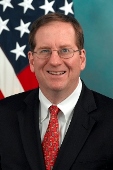The Continuing Need to Close the Guantanamo Bay Detention Facility
On Sunday, John Bellinger forcefully summarized the main arguments for closing the detention facility at Guantanamo Bay, Cuba. Having served as the Department of Defense Special Envoy for Guantanamo Detention Closure in the Obama Administration and as Director of the DOD Office of Legislative Counsel at the end of the Bush Administration, I agree with John’s conclusion. While a safe, humane facility, GTMO hurts us more than it helps us.
Published by The Lawfare Institute
in Cooperation With

On Sunday, John Bellinger forcefully summarized the main arguments for closing the detention facility at Guantanamo Bay, Cuba. Having served as the Department of Defense Special Envoy for Guantanamo Detention Closure in the Obama Administration and as Director of the DOD Office of Legislative Counsel at the end of the Bush Administration, I agree with John’s conclusion. While a safe, humane facility, GTMO hurts us more than it helps us. If we want to protect the country, we should close the GTMO detention facility.
We are all familiar with the primary arguments to close GTMO: it costs too much, it is a recruiting tool and propaganda tool for terrorists (a conclusion reached by both President Bush and President Obama), and it is disdained by the international community. But beyond these individual factors, it is crucially important that the national security leadership of both the Bush and Obama Administration reached the same conclusion. In the best judgement of both Administrations, GTMO hurt us more than it helped us. Both presidents, five secretaries of Defense (Rumsfeld, Gates, Panetta, Hagel, and Carter), and four secretaries of State (Powell, Rice, Clinton, and Kerry) reached the same conclusion. (Yes, even Secretary of Defense Donald Rumsfeld ultimately concluded GTMO should be closed—if an alternative location were selected.)
I urge the new Administration to reach the same conclusion. As John states, before bringing new detainees to GTMO, the new Administration would be wise to consult with the bipartisan national security experts from both previous Administrations. This list of experts includes a long list of retired military leaders, including former Marine Commandant, Gen. Charles Krulak and former CENTCOM Commander General Joseph Hoar.
This does not mean the United States should not detain new captures or no longer detain those confined at GTMO who are too dangerous to transfer. Detaining those defined by Congress as terrorists keeps them off the battlefield and allows useful interrogation. The Administration can decide which tool to use for each new detainee: detention, prosecution under Article III courts, prosecution under military commissions, or transfer to a foreign country (the home country or a third country) with adequate security assurances vetted by national security professionals.
With that in mind, here’s my advice to the Trump Administration:
Transfer the 41 remaining detainees at GTMO to a secure military brig or federal detention facility in the United States and remove the issues regarding GTMO that hurt us around the world. It will ultimately cost far less to detain these 41 prisoners in the United States (see the closure plan sent to Congress by the Obama Administration in February 2016)—and our allies, who we need in our counterterrorism efforts around the world, will thank us. Terrorists will probably still decry a new facility, but they won’t have the GTMO baggage to argue. Make sure the new facility is as transparent as possible (the media won’t have to queue for limited space on transport planes) and continue the judicial and administrative review already in place. This won’t convince the enemy, but it takes the issue off the table for the reasonable members of the international community. Also, use this new domestic detention facility for new captures who are not deemed appropriate for federal prosecution.
Continue to transfer those detainees from GTMO or the new facility for whom it is safe to do so. Five detainees at GTMO are currently eligible for transfer if adequate security assurances are obtained. These assurances, as negotiated by the Departments of State and Defense, and reviewed by the Attorney General, the Secretary of Homeland Security— who knows GTMO extremely well from his SOUTHCOM days—the Director of National Intelligence, and the Chairman of the Joint Chiefs of Staff, have worked well with most recent transfers. Basically, they require the host nation to be able to monitor the former detainee, deny travel documents, share information with the United States government regarding the former detainee, and rehabilitate or integrate the detainee into the new country.
When in doubt, don’t transfer. But keep in mind that the international community has learned how to do this in the fifteen years since GTMO opened.
Retain the current Periodic Review Board Process. This broad interagency administrative process, conceived by the Obama Administration, addressed the international community’s concern that GTMO was a legal black hole. It followed earlier DOD reviews under the Bush Administration. Both Administrations concluded the continuing threat of detainees needs to be reviewed. At a minimum, even if the Trump Administration concludes that GTMO should stay open and add detainees, it must acknowledge that detention by United States authorities is rarely permanent and the ability to review the continuing threat of detainees with the possibility of safe transfer, must be retained. For these reasons, the Bush Administration transferred over 530 detainees from GTMO and the Obama Administration transferred almost 200 detainees.
Detention is lawful when the United States uses force, but GTMO is not the way to do it.


.jpg?sfvrsn=8253205e_5)
.jpg?sfvrsn=a9413207_5)

